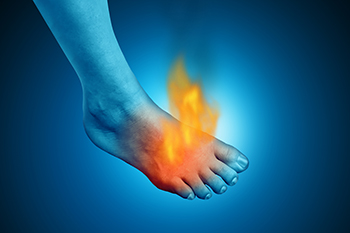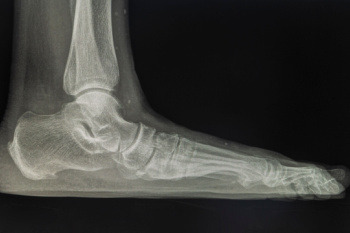Glen Allen Office
(804) 747-3380

Burn injuries on the feet can occur from scalding liquids, stepping on hot surfaces, or chemical exposure. They are common in people who walk barefoot or work in environments with high heat or hazardous materials. These burns can be particularly concerning due to the foot's thinner skin and role in mobility. Immediate care involves cooling the burn under lukewarm water and gently cleaning it to remove debris. Cover the wound with a sterile, non-stick bandage and elevate the foot to reduce swelling. If you have sustained a burn foot wound, it is strongly suggested that you promptly contact a podiatrist to assess the burn's severity, prevent infection, and develop a treatment plan. Burns can lead to complications, such as infections or tissue damage, so care from this type of doctor is essential for effective healing and recovery.
Wound care is an important part in dealing with diabetes. If you have diabetes and a foot wound or would like more information about wound care for diabetics, consult with one of our podiatrists from The Podiatry Center. Our doctors will assess your condition and provide you with quality foot and ankle treatment.
What Is Wound Care?
Wound care is the practice of taking proper care of a wound. This can range from the smallest to the largest of wounds. While everyone can benefit from proper wound care, it is much more important for diabetics. Diabetics often suffer from poor blood circulation which causes wounds to heal much slower than they would in a non-diabetic.
What Is the Importance of Wound Care?
While it may not seem apparent with small ulcers on the foot, for diabetics, any size ulcer can become infected. Diabetics often also suffer from neuropathy, or nerve loss. This means they might not even feel when they have an ulcer on their foot. If the wound becomes severely infected, amputation may be necessary. Therefore, it is of the upmost importance to properly care for any and all foot wounds.
How to Care for Wounds
The best way to care for foot wounds is to prevent them. For diabetics, this means daily inspections of the feet for any signs of abnormalities or ulcers. It is also recommended to see a podiatrist several times a year for a foot inspection. If you do have an ulcer, run the wound under water to clear dirt from the wound; then apply antibiotic ointment to the wound and cover with a bandage. Bandages should be changed daily and keeping pressure off the wound is smart. It is advised to see a podiatrist, who can keep an eye on it.
If you have any questions, please feel free to contact one of our offices located in Richmond and Glen Allen, VA . We offer the newest diagnostic and treatment technologies for all your foot care needs.

Heel pain, especially in the morning, is a common complaint, often caused by plantar fasciitis, an inflammation of the tissue connecting the heel to the toes. People with this condition experience sharp pain in the heel, especially when taking the first few steps after getting out of bed. The pain typically lessens after walking for a while, but can return after long periods of standing or activity. Plantar fasciitis is commonly caused by overuse, poor foot mechanics, tight calf muscles, or wearing unsupportive footwear. Other conditions like heel spurs or Achilles tendonitis can also contribute to morning heel pain. Relief options include stretching exercises and wearing supportive shoes or custom orthotics. In more severe cases, a podiatrist may recommend corticosteroid injections to reduce inflammation. If you have heel pain in the morning, it is suggested that you schedule an appointment with a podiatrist.
Many people suffer from bouts of heel pain. For more information, contact one of our podiatrists of The Podiatry Center. Our doctors can provide the care you need to keep you pain-free and on your feet.
Causes of Heel Pain
Heel pain is often associated with plantar fasciitis. The plantar fascia is a band of tissues that extends along the bottom of the foot. A rip or tear in this ligament can cause inflammation of the tissue.
Achilles tendonitis is another cause of heel pain. Inflammation of the Achilles tendon will cause pain from fractures and muscle tearing. Lack of flexibility is also another symptom.
Heel spurs are another cause of pain. When the tissues of the plantar fascia undergo a great deal of stress, it can lead to ligament separation from the heel bone, causing heel spurs.
Why Might Heel Pain Occur?
Treatments
Heel pain should be treated as soon as possible for immediate results. Keeping your feet in a stress-free environment will help. If you suffer from Achilles tendonitis or plantar fasciitis, applying ice will reduce the swelling. Stretching before an exercise like running will help the muscles. Using all these tips will help make heel pain a condition of the past.
If you have any questions please contact one of our offices located in Richmond and Glen Allen, VA . We offer the newest diagnostic and treatment technologies for all your foot and ankle needs.

Flat feet, or fallen arches, occur when the arches of the feet collapse or do not form properly, leading to the entire sole making contact with the ground. This condition affects the biomechanics of walking and running, as the natural shock absorption provided by the arches is diminished. Without the arch, the foot tends to over-pronate, meaning it rolls inward excessively during movement. This alters the alignment of the ankle, knee, and hip, potentially leading to discomfort or pain in these areas. The abnormal motion can also increase strain on the ligaments and tendons of the foot, resulting in inflammation and fatigue. Over time, flat feet can contribute to conditions like plantar fasciitis, tendinitis, or even joint problems due to improper weight distribution. Understanding the biomechanics of flat feet is essential for identifying the best treatment options, such as orthotics or corrective exercises. If you have flat feet, it is suggested that you are under the care of a podiatrist who can help you to manage this condition.
If you have any concerns about your feet, contact one of our podiatrists from The Podiatry Center. Our doctors can provide the care you need to keep you pain-free and on your feet.
Biomechanics in Podiatry
Podiatric biomechanics is a particular sector of specialty podiatry with licensed practitioners who are trained to diagnose and treat conditions affecting the foot, ankle and lower leg. Biomechanics deals with the forces that act against the body, causing an interference with the biological structures. It focuses on the movement of the ankle, the foot and the forces that interact with them.
A History of Biomechanics
Modern technological improvements are based on past theories and therapeutic processes that provide a better understanding of podiatric concepts for biomechanics. Computers can provide accurate information about the forces and patterns of the feet and lower legs.
Understanding biomechanics of the feet can help improve and eliminate pain, stopping further stress to the foot.
If you have any questions please feel free to contact one of our offices located in Richmond and Glen Allen, VA . We offer the newest diagnostic and treatment technologies for all your foot and ankle needs.

Gout is often considered a condition that primarily affects men, but it can also impact women, particularly after menopause. This painful form of arthritis is caused by a buildup of uric acid in the body, leading to the formation of crystals in the joints. For women, hormonal changes, especially the decrease in estrogen after menopause, can increase the risk of gout. Other contributing factors include obesity, high blood pressure, and a diet rich in purine-heavy foods such as red meat, seafood, and alcohol. Symptoms of gout in women are similar to those in men and typically include sudden, intense pain, swelling, and redness in the affected joint, often starting in the big toe. Managing gout involves lifestyle changes such as maintaining a healthy weight, avoiding certain foods and drinks, staying hydrated, and taking medications as prescribed to reduce uric acid levels and prevent flare-ups. Gout can cause severe pain and foot discomfort. If you have symptoms of gout in your feet, it is suggested that you are under the care of a podiatrist who can accurately diagnose and treat this condition.
Gout is a foot condition that requires certain treatment and care. If you are seeking treatment, contact one of our podiatrists from The Podiatry Center. Our doctors will treat your foot and ankle needs.
What Is Gout?
Gout is a type of arthritis caused by a buildup of uric acid in the bloodstream. It often develops in the foot, especially the big toe area, although it can manifest in other parts of the body as well. Gout can make walking and standing very painful and is especially common in diabetics and the obese.
People typically get gout because of a poor diet. Genetic predisposition is also a factor. The children of parents who have had gout frequently have a chance of developing it themselves.
Gout can easily be identified by redness and inflammation of the big toe and the surrounding areas of the foot. Other symptoms include extreme fatigue, joint pain, and running high fevers. Sometimes corticosteroid drugs can be prescribed to treat gout, but the best way to combat this disease is to get more exercise and eat a better diet.
If you have any questions please feel free to contact one of our offices located in Richmond and Glen Allen, VA . We offer the newest diagnostic and treatment technologies for all your foot and ankle needs.